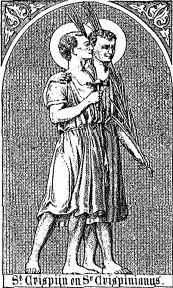St. Crispin – Our Patron Saint

Shoemaking history is rich in tradition. Saint Crispin is the most commonly recognized patron saint of shoemakers, though there have been others. Since medieval times, October 25th has been celebrated as St. Crispin's Day feast day and the shoemakers’ holiday. In the past, boot and shoemakers closed their shops on this day in celebration and commemoration.
There are two Saint Crispin traditions that seem to be the same—one in England, one in France.
The French say Crispin and his brother Crispianus were born into a wealthy Roman family in the third century A.D. During the Diocletian persecution of Christians they escape to Noviodunum in France—later known as Soissons. Effectively disinherited and forced to fall back upon their own resources, Crispin and Crispianus become shoemakers. Though teaching the gospel was their life's work, they made shoes for the poor. Arrested and led before the Roman authorities, they were urged to recant. Both refused. Millstones were hung about their necks and they were thrown into the river Aisne. But both had the makings of sainthood in them even then and they refused to drown. At this point they were thrown into a cauldron of boiling lead, then a cauldron of pitch, then fat and oil but, they emerged unscathed. Legend suggests that they frolicked and sang until delivered by an angel. They were beheaded on November 8th, 288 A.D. on a plain near Soissons, which later became known as St. Crepin-en-Chaye.
The English version depicts Crispin and his brother as the sons of the queen of Logia, or Kent. To escape the persecution of Christians by Diocletian, the brothers dressed in commoners’ clothes and left their mother and the town of their birth—now known as Canterbury. Arriving in Faversham in the middle of the night, they knocked on a door from which a merry song emanated. This was the house of Robards, a master shoemaker. Impressed by their manners, Robards took them in. Straightaway they entered a seven year apprenticeship. So good was their work that Robards soon found himself appointed shoemaker to Maximinus, Diocletian's associate Emperor. Sent to Canterbury with shoes for Ursula, the Emperor’s daughter, Crispin was struck by her beauty and fell in love with her. After all the trials and tribulations that love and class can inflict upon them, Ursula and Crispin secretly married. When Maximinus learned of Crispin's high birth, he became reconciled to their marriage and blessed their son saying: "A shoemaker's son is a prince born." The marriage was confirmed October the 25th and celebrated with feasting and drinking. That day has ever since been the shoemakers' holiday.
Although the story is probably a 15th- or 16th-century retelling of the Crispin legend, we know a little more about St. Hugh, who, although never canonized, was the English counterpart to St. Crispin. Hugh was born a prince of Britain, son of Arviragus–king of Powisland, or modern Wales. He fell in love with a beautiful Christian princess, Winifred of Flintshire. Winifred's story has many of the elements of the 7th-century Saint Winifred of Holywell and Shrewsbury fame. Her appearance in the legend of St. Hugh is similar in that having taken a vow of chastity, she spurns Hugh's overtures. In despair, Hugh journeys across Europe. At last tired and convinced that he has mistaken Winifred's intentions, he took passage back to England. Mid-journey his ship was caught in a storm and Hugh was the only survivor. When he made it back to his home, he was destitute. Thrown back his own resources, Hugh became a shoemaker, preaching the gospel by day and plying his craft by night. Hugh renewed his suit of Winifred, who, like her namesake, was now living by a spring, but to his dismay, the results are the same. When Winifred was arrested and condemned to death for her devotion to God, Hugh set off to Flintshire. There he spoke so highly of her and praised her so lavishly, that he was imprisoned and condemned to share her fate. According to the story, Hugh and Winifred were put to death about 300 A.D.. Winifred was bled to death in emulation of the wounds Christ received. Hugh was made to drink a poisoned cup of her blood, and was hanged. Legend has it that his fellow shoemakers kept vigil and consoled him during the time of his imprisonment. As he drank from the poisoned cup, he bequeathed all his worldly goods to his friends. Since he was destitute, all he had to leave them was his bones After his death, his friends pulled his body from the gibbet and distributed his bones. These were made into shoemaking tools. For many years a shoemaker's tool kit was called St. Hugh's Bones.
Title Page
click here for more information
